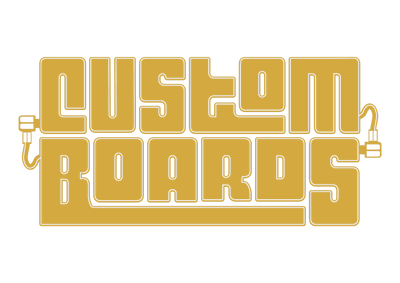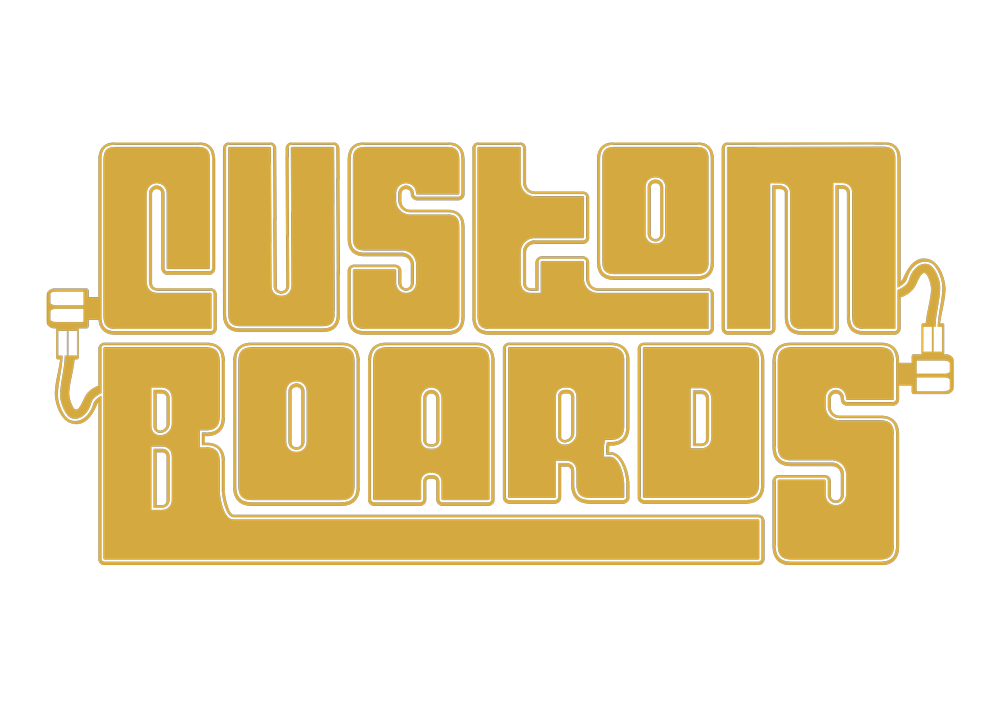Voltage and current – How do I know what power my pedals need?
Planning the power requirements of your pedalboard is best done neatly on a piece of paper or using a spreadsheet software. You will find the values either printed directly on the pedal or its label, or by reading the owner’s manual.
The values you need to know are:
- V = volts (called the voltage). Take care to always check the input voltage first, as a too-high voltage could damage your effect.
- A = amperes (called the current; usually in mA = milliamperes). Next check the pedal’s current draw (mA). A too-high current won’t damage your pedal (in contrast to incorrect voltage), which means it is not a problem to connect a pedal drawing only 10 mA to a 100 mA power supply output. The pedal will only take in the amount of current it needs. If you have a lot of current surplus, you can use the output in question to power additional effects by using a output splitter cable.
- AC or DC. Check for the type of power. Never connect an AC-outlet to a DC-pedal, or vice versa, to prevent damaging your pedals. Most pedal effects will run on DC. Pedals that run on AC-power are usually types that include a tube circuit in their electronics. Some older digital effects also require AC-power. This days trend seems to be that most effect pedals run on 9 volts DC, with less and less AC-pedals can be found on the market.
Be very careful whenever you are about to connect a pedal to an AC-output on your power supply, because some DC-pedals can be seriously damaged if AC is fed to them.
All of the effects Custom Boards offers come with an online list of these specifications. For pedals bought elsewhere, you should consult the manual or the manufacturer’s website. It’s easiest to find the data on the Internet if you use the correct key words for your search, along with the pedal’s name:
– current draw
– power draw
– mA draw
– power consumption
– power adapter specs
Power needs for different effect types
It will be easier to plan your pedalboard’s power layout if you already have a broad understanding of the different effect types and their usual power requirements. A broad generalization would be:
- Traditional overdrives, distortions, boosters and wah-wahs run on very little current, and usually need only between 4 and 20 mA.
- Digital tuners and modulation effects tend to stay in the middle, usually needing somewhere between 40 and 60 mA.
- Early digital effect units, which still run on nine-volt batteries, need between 60 and 80 mA of current. Generally, if the device can be run using a nine-volt battery, 80 mA is normally the upper limit.
- Digital effects from the first decade of this millenium, like Boss’ double-pedals or many digital EHX-models, need 150 to 200 mA. The same goes for most MIDI-controllers.
- True Bypass loopers meant for use on pedalboards use somewhere between 150 and 400 mA, depending on their features.
- Modern digital pedals – like Strymon- or Source Audio-effects – generally need between 200 and 300 mA.
- Eventide-effects tend to be quite power-hungry, needing currents between 400 and 500 mA.
- More than 500 mA are usually only required by pro-grade multi-effects or some pedal-sized preamps.
Polarities and connectors
The last two points to take into account are:
- DC-polarity.
- Type of plug needed to connect the effect to the power supply.
The plug’s specifications are made up of the connector type and the connector size. The polarity is usually given as a graphic symbol for a connector’s tip/center and sleeve, or as a written term “center negative”/”center positive”. Note these specifications in your list, too. 

Making a power plan
Here is an example of the chart that you can do by yourself. Fill in the specifications for each pedal you plan to attach to your pedalboard.
| Pedal | Voltage | AC/DC | Plug type | Current draw (mA) |
| Fulltone OCD | 9-18 V | DC | 2.1 mm/center negative | 8 mA |
| Strymon Mobius | 9 V | DC | 2.1 mm/center negative | 300 mA |
| Fulltone ’69 Fuzz | 9 V | DC | 2.1 mm/center positive | 2 mA |
Here are a real world examples of our "Pedal Power Service".
Case 1
Effects: Analogman Mini Chorus, Dunlop Original Crybaby GCB95, Fulltone OCD, Mad Professor Little Green Wonder, MXR Dyna Comp, Neunaber Immerse Reverberator, Simble, Strymon El Capistan, Walrus Audio Monument
Possible additions: None at the moment, but some pedals may be swapped. The Crybaby could be swapped for a Fulltone Clyde Wah, and the Dyna Comp could become a Mad Professor Forest Green Compressor in the future.
Pedalboard: Pedaltrain Classic 1
Recommended PSU: Voodoo Lab Pedal Power 2 Plus
Additionally required are: Voodoo Lab Output Splitter -cable and an additional cable for use with the splitter. We’d recommed using cable with straight plug on the other end with Output Splitter. Remember to secure the connection with electrician’s tape.
The power supply will be installed to the Pedaltrain Classic 1 using a Pedaltrain Voodoo Lab Mounting Kit.
You will have to drill 3 mm holes for the mounting kit with this drill bit.
Leave all the DIP-switches on the power supply’s underside in their NORMAL positions. All pedals use the standard DC-cables in black with the standard 2.1 mm plugs. Depending on the year of manufacture the Dyna Comp might require a mini-plug, but this cable is also included with the Voodoo Lab Pedal Power 2 Plus.
Connect the pedals as follows:
- Output 1 (9V 100 mA): Analogman Mini Chorus
- Output 2 (9V 100 mA): Dunlop Crybaby CGB95 (also works with a Fulltone Clyde Wah). Use a straight plug for the wah-wah, because of the thickness of the pedal’s housing. An angled plug might be prone to pop out.
- Output 3 (9V 100 mA): Fulltone OCD
- Output 4 (9V 100 mA): OUTPUT SPLITTER: Mad Professor Little Green Wonder & Mad Professor Simble. Connect the Little Green Wonder to the black-and-white cable and the Simble to the all-black cable.
- Output 5 (9V 250 mA): Strymon El Capistan
- Output 6 (9V 250 mA): Walrus Audio Monument
- Output 7 (9V 100 mA): MXR Dyna Comp (also works with the Mad Professor Forest Green Compressor)
- Output 8 (9V 100 mA): Neunaber Immerse
Case 2
Effects: BOSS Tuner TU-2, MXR Dyna comp, BJF Baby Blue, BOSS Combo Drive BC-2, BOSS Equalizer GE-7, BOSS Chorus CE-3, BOSS Gigadelay DD-20, Strymon Big Sky, Digitech Jamman Solo XT
Possible additions: The Boss Gigadelay could be swapped to a Strymon Timeline (or similar) in the future. There’s also the addition of a mini-sized pedal coming up soon, which means the PSU should have enough power reserves.
Pedalboard: Pedaltrain Classic 1
Recommended PSU: Cioks DC10 Link. This power supply will power all the pedals, even leaving one output vacant for later use.
The Cioks DC10 Link will be mounted to the Pedaltrain Classic 1 with Pedaltrain True Fit Mounting Kit - Large.
You will have to drill 3 mm holes for the mounting kit with this drill bit.
Should the Boss CE-3 be an old model, requiring a Boss 12 V ACA-power supply, switch the DIP-switch of this output to “12 V”, but leave the rest set to “9 V”. All pedals work with the black standard cable and the standard 2.1 mm plug.
Connect the pedals as follows:
- Output 1 (9V 100 mA): Boss TU-2 Tuner
- Output 2 (9V 100 mA): Boss GE-7 Equalizer
- Output 3 (9/12V 100 mA): Boss CE-3 Chorus (switch the DIP-switch to “12 V”, if the label on the pedal reads "Use ACA-adapter only")
- Output 4 (9/12V 100 mA): MXR Dyna Comp
- Output 5 (9/12V 200 mA): BJFe Baby Blue OD
- Output 6 (9/12V 200 mA): Digitech Jamman XT
- Output 7 (9/12V 400 mA): Boss BC-2 Combo Drive
- Output 8 (9V 400 mA): Boss DD-20 Giga Delay. Should you swap to a Strymon Timeline you can use the same output. For other future effects use either this output or the adjustable output 10, which is currently vacant.
- Output 9 (9V 400 mA): Strymon BigSky
- Output 10 (9-24V 800-300 mA): not in use
*****
If you have purchased all the parts and components but get a feeling that you might not be up to the task after all, we can make your pedalboard for you, using the components you have bought from us. Don’t worry, we won’t let anything go to waste.

